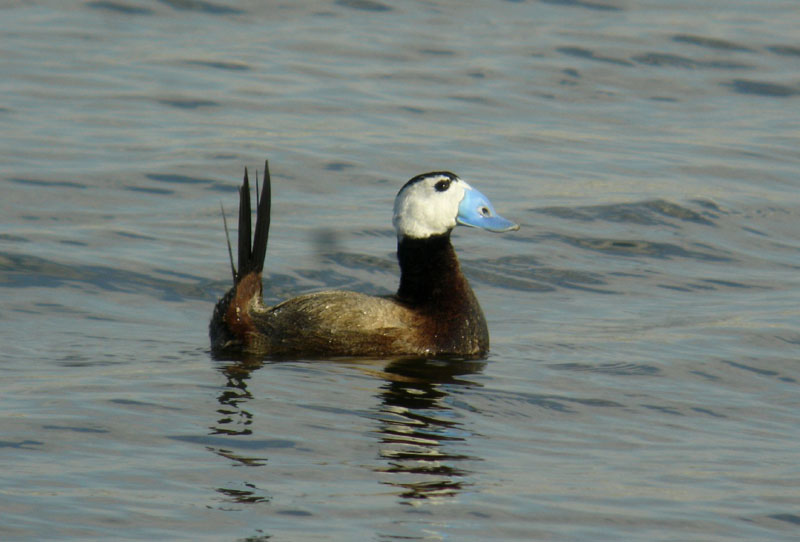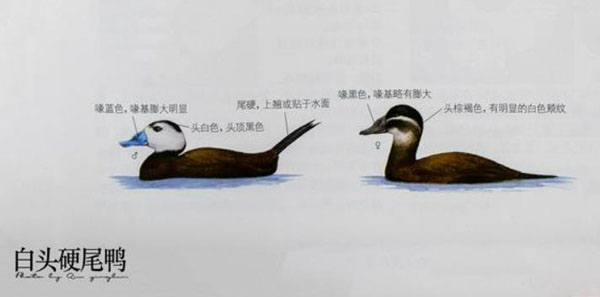Oxyura leucocephala
IUCN
LCBasic Information
Scientific classification
- name:Oxyura leucocephala
- Scientific Name:Oxyura leucocephala,White-headed Duck
- Outline:Waterfowl
- Family:Anseriformes Anatidae Duck
Vital signs
- length:43-48cm
- Weight:539-900g
- lifetime:20years
Feature
It is recognized as a globally endangered bird species and is the prototype of Donald Duck in the cartoon.
Distribution and Habitat
In China, summer migratory birds are found in northwest Xinjiang and near Urumqi, and stray birds are found in Hubei. Abroad, they are distributed in southeastern Europe, central and western Asia, and northwest Africa.
During the breeding season, white-headed hardtail ducks mainly inhabit freshwater lakes in open plains, especially some shallow lakes and ponds close to large lakes, especially freshwater lakes with shore plants and emergent plants, and occasionally saltwater lakes. In winter, they mainly inhabit large open lakes, especially lakes with waterside plants, and also inhabit saltwater lakes and coastal areas.
Appearance
Medium-sized, with a peculiar beak. The male is brown all over, with a white head, dark brown on the top of the head and collar, and the entire body and tail are chestnut brown of varying shades. The female and young birds have similar feathers to the male, with a dark brown top of the head connected to the upper back through the back of the neck, and obvious dark brown horizontal stripes on the lower cheek. The iris is yellow, and the female is lighter in color. The male's beak is gray-blue with a swollen base, while the female's beak is gray-black with a smaller swollen base, and the feet are gray.
Details
The white-headed hardtail duck is a very typical gregarious water duck. It breeds in Tianshan Mountain in Xinjiang and is occasionally seen in Honghu Lake in Hubei. It is a summer migratory bird in Xinjiang and an occasionally stray bird in Hubei. It mainly forages by diving, and often sticks its head out to forage in shallow water near the water. It mainly feeds on aquatic plants such as pondweed and water plants, and also eats aquatic animals such as insect larvae, small fish, frogs, crustaceans, mollusks, and worms. It is very afraid of people and will take off immediately at the slightest movement. It is good at swimming and diving, and often lifts its tail high when swimming.

Except for the breeding season, they usually move in small groups. Good at swimming and diving. They often move in waters near aquatic plants. When swimming, their tail is tilted upwards. They can float lightly in the water, or sink their bodies into the water, leaving only their heads and tails on the water surface, especially when they encounter danger. They usually do not move on land, and rarely fly. Even if there is danger, they often escape by diving, swimming, or hiding. It is difficult to walk on the ground, and it is also clumsy to take off. It needs to flap its wings rapidly on the water surface for a while before it can fly. Except for the breeding season, they rarely sing, and they are silent when they are active.

The breeding season of the white-headed hard-tail duck is from May to July. Pairs are formed mainly on the way to spring migration and after arriving at the breeding grounds. The combination of pairs is generally short-lived and not firm, usually only a temporary combination during the breeding period. Breeding in open inland lakes, ponds and swamps. Nests are built in shrubs or grass on the ground near the water, and floating nests are also built in reeds near open water. Each nest lays 6-10 eggs. The eggs are white, 63-73×48-54 mm in size, 66×50 mm on average, weighing 97 grams, and the incubation period is 25 days.

The white-headed hard-tailed duck, an endangered wild animal in the world and China, is globally vulnerable, extremely rare, and its current status is unknown. There are breeding records in the Junggar Basin and Tianshan area in western Xinjiang. There have been sporadic individuals seen in Ordos in western Inner Mongolia, and there have been wintering records in Honghu, Hubei. According to the latest statistics from Wetlands International, the global population of white-headed hard-tailed ducks is 8,000-13,000.
Listed in China's "National Key Protected Wildlife List" (February 5, 2021) at level one.








